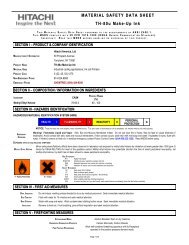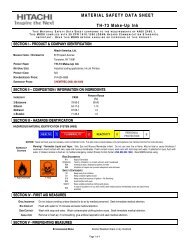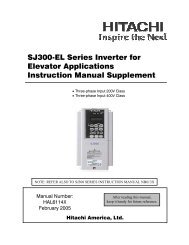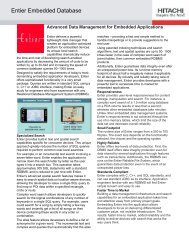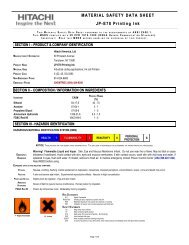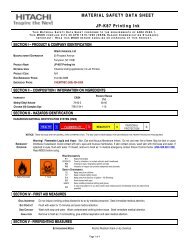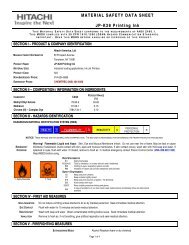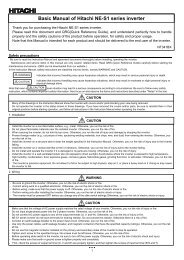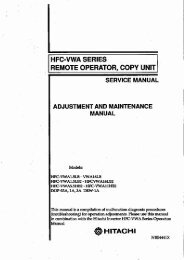SJ700-2 Instruction Manual NT204DX - Hitachi America, Ltd.
SJ700-2 Instruction Manual NT204DX - Hitachi America, Ltd.
SJ700-2 Instruction Manual NT204DX - Hitachi America, Ltd.
You also want an ePaper? Increase the reach of your titles
YUMPU automatically turns print PDFs into web optimized ePapers that Google loves.
Chapter 2 Installation and Wiring<br />
(1) Explanation of main circuit terminals<br />
Symbol Terminal name Description<br />
R, S, T<br />
Connect to the AC power supply.<br />
Main power input<br />
(L1, L2, L3)<br />
Leave these terminals unconnected when using a regenerative converter (HS900 series).<br />
U, V, W<br />
(T1, T2, T3)<br />
Inverter output Connect a 3-phase motor.<br />
PD, P<br />
Remove the jumper from terminals PD and P, and connect the optional power factor reactor<br />
DC reactor connection<br />
(+1, +)<br />
(DCL).<br />
P, RB<br />
(+, RB)<br />
External braking<br />
resistor connection<br />
Connect the optional external braking resistor.<br />
(The RB terminal is provided on models with 22 kW or less capacity.)<br />
P, N Regenerative braking<br />
(+, -) unit connection<br />
Connect the optional regenerative braking unit (BRD).<br />
G<br />
Connect to ground for grounding the inverter chassis by type-D grounding (for 200 V class<br />
Inverter ground<br />
models) or type-C grounding (for 400 V class models).<br />
(2) Explanation of control circuit terminals<br />
Analog<br />
Digital (contact)<br />
Power<br />
supply<br />
Frequency setting input<br />
Monitor output<br />
Monitor output<br />
Power supply<br />
Operation<br />
command<br />
Symbol Terminal name Description Electric property<br />
L<br />
Analog power<br />
supply<br />
(common)<br />
This common terminal supplies power to frequency command terminals (O,<br />
O2, and OI) and analog output terminals (AM and AMI). Do not ground this<br />
terminal.<br />
H<br />
O<br />
O2<br />
OI<br />
AM<br />
AMI<br />
FM<br />
P24<br />
CM1<br />
FW<br />
Frequency<br />
setting power<br />
supply<br />
Frequency<br />
command<br />
(voltage)<br />
Auxiliary<br />
frequency<br />
command<br />
(voltage)<br />
Frequency<br />
command<br />
(current)<br />
Analog monitor<br />
(voltage)<br />
Analog monitor<br />
(current)<br />
Digital monitor<br />
(voltage)<br />
Interface power<br />
supply<br />
Interface power<br />
supply<br />
(common)<br />
Forward rotation<br />
command<br />
This terminal supplies 10 VDC power to the O, O2, OI terminals.<br />
Allowable load current: 20<br />
mA or less<br />
Input a voltage (0 to 10 VDC) as a frequency command. 10 V specifies the<br />
Input impedance: 10kΩ<br />
maximum frequency.<br />
Allowable input voltages:<br />
To specify the maximum frequency with a voltage of 10 V or less, set the<br />
-0.3 to +12 VDC<br />
voltage using function "A014".<br />
Input a voltage (0 to ±10 VDC) as a signal to be added to the frequency<br />
Input impedance: 10kΩ<br />
command input from the O or OI terminal. You can input an independent<br />
Allowable input voltages:<br />
frequency command from this terminal (O2 terminal) alone by changing the<br />
0 to ±12 VDC<br />
setting.<br />
Input a current (4 to 20 mA DC) as a frequency command. 20 mA specifies<br />
Input impedance: 10kΩ<br />
the maximum frequency.<br />
Maximum allowable<br />
The OI signal is valid only when the AT signal is on. Assign the AT function<br />
current: 24 mA<br />
to an intelligent input terminal.<br />
This terminal outputs one of the selected "0 to 10 VDC voltage output"<br />
monitoring items. The monitoring items available for selection include<br />
Maximum allowable<br />
output frequency, output current, output torque (signed or unsigned),<br />
current: 2 mA<br />
output voltage, input power, electronic thermal overload, LAD frequency,<br />
motor temperature, heat sink temperature, and general output.<br />
This terminal outputs one of the selected "4 to 20 mA DC current output"<br />
monitoring items. The monitoring items available for selection include<br />
Allowable load impedance:<br />
output frequency, output current, output torque (unsigned), output voltage,<br />
250Ω or less<br />
input power, electronic thermal overload, LAD frequency, motor<br />
temperature, heat sink temperature, and general output.<br />
This terminal outputs one of the selected "0 to 10 VDC voltage output<br />
(PWM output mode)" monitoring items. The monitoring items available for<br />
selection include output frequency, output current, output torque Maximum allowable<br />
(unsigned), output voltage, input power, electronic thermal overload, LAD current: 1.2 mA<br />
frequency, motor temperature, heat sink temperature, general output, Maximum frequency: 3.6<br />
digital output frequency, and digital current monitor.<br />
kHz<br />
For the items "digital output frequency" and "digital current monitor," this<br />
terminal outputs a digital pulse signal at 0/10 VDC with a duty ratio of 50%.<br />
This terminal supplies 24 VDC power for contact input signals.<br />
Maximum allowable output<br />
If the source logic is selected, this terminal is used as a common contact<br />
current: 100 mA<br />
input terminal.<br />
This common terminal supplies power to the interface power supply (P24),<br />
thermistor input (TH), and digital monitor (FM) terminals. If the sink logic is<br />
selected, this terminal is used as a common contact input terminal. Do not<br />
ground this terminal.<br />
Turn on this FW signal to start the forward rotation of the motor; turn it off to<br />
stop forward rotation after deceleration.<br />
[Conditions for turning<br />
contact input on]<br />
Voltage across input and<br />
PLC: 18 VDC or more<br />
Contact input<br />
Function selection and logic<br />
switching<br />
1<br />
2<br />
3<br />
4<br />
5<br />
6<br />
7<br />
8<br />
Intelligent input<br />
Select eight of a total 60 functions, and assign these eight functions to<br />
terminals 1 to 8.<br />
Note:<br />
If the emergency stop function is used, terminals 1 and 3 are used<br />
exclusively for the function. For details, see Item (3), "Emergency stop<br />
function" (on page 2-8).<br />
Input impedance between<br />
input and PLC: 4.7kΩ<br />
Maximum allowable voltage<br />
across input and PLC: 27<br />
VDC<br />
Load current with 27 VDC<br />
power: about 5.6 mA<br />
2 - 7




